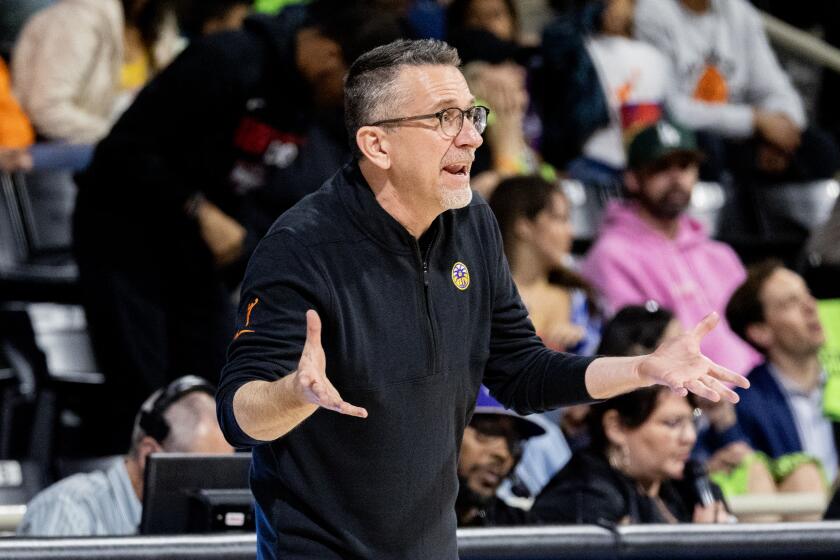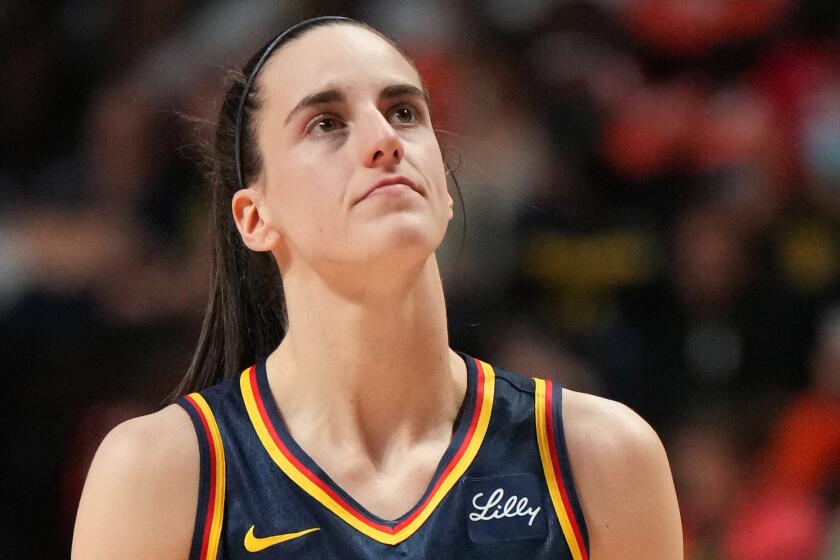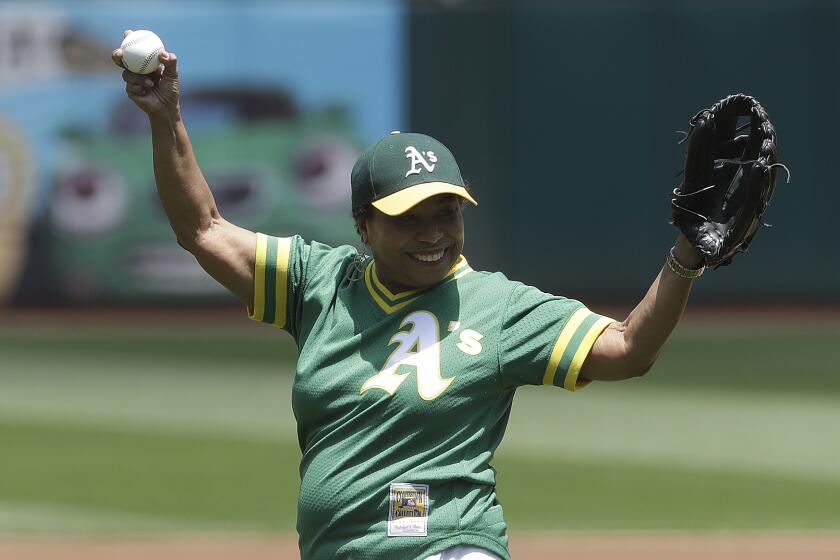Lone Star mother ship
Excess may be a dirty word in many facets of American life, but for sports fans who revel in it, this is a pretty swell year. With a couple of billion-dollar stadiums opening their doors for the first time, 2009 measures up in the history of mankind alongside AD 80, the year the Roman Colosseum opened its doors.
In April, the New York Yankees’ $1.2-billion palace was unveiled. That stadium was both imperious and a bit chilly -- not unlike the team itself -- and ultimately underwhelming, a more comfortable mirror of the team’s old home right next door.
That won’t be an issue tonight in Texas. In fact, take any ancient Roman sports spectator you can find to the new $1.2-billion Cowboys Stadium in Arlington, site of its first regular-season National Football League game today, and he’ll be gawking at the splendiferous setting.
At 3 million square feet, the stadium is among the largest air-conditioned spaces in the world. By contrast, the Cowboys’ previous home, Texas Stadium, its 900,000 square feet moldering not far away and slated for tear-down, would fit neatly inside.
With its sloping, cantilevered glass and steel exteriors and open roofs --the top is retractable -- the new stadium has an eerie resemblance to the massive spacecraft dwarfing cities in “Independence Day,” the 1996 doomsday sci-fi epic. Cowboys Stadium is clearly the mother ship.
Understatement (really)
For all the spaciousness and grandeur -- after all, everything’s supposed to be big in Texas, right? -- the interior is surprisingly understated and welcoming. In fact, you can see it all and get in half a mile of pre-game exercise by walking around its upper level.
The palette is a sophisticated mix of silvery steel, charcoal and navy blue punctuated by colorful murals splashing the concourses and ramp ways. Contrary to expectation, Cowboys’ stuff is not plastered everywhere; it’s largely confined to more than 400 small video screens dotting posts, pillars and food stands.
In the words of Cole Porter, a man not usually associated with the gridion: The place is swellegant.
To achieve that balance, design elements were culled from sources other than sports enormo-domes. Planners drew from the glass walls at the upcoming Frank Gehry-designed Louis Vuitton museum in Paris; the appointment of outdoor spaces adjacent to the stadium and the trees, grass and walkways were inspired by public spaces in Chicago’s Grant Park; the idea for oversized video boards came when team owner Jerry Jones saw Celine Dion perform at Caesars Palace.
“Jerry realized,” said Cowboys spokesman Brett Daniels, “that even from a close seat he spent as much time watching her image on the huge screen behind the stage as he did the singer herself.”
Screen vs. real life
Thus, Dion, projected live, was deemed as visually compelling as Dion, live. It’s a conclusion Dion might resist, but that’s how it rolls at Cowboys Stadium.
In fact, once you stop sightseeing and settle in to watch the game, the dual video screens towering over the field become the experience, an afternoon in the world’s biggest sports bar. The technology is simultaneously defining and daunting -- facing each sideline, the screens use 36 million LEDs (light-emitting diodes) to display more than 25,000 square feet of imagery. The boards stretch 60 yards long, projecting figures up to 70 feet tall.
It’s not without its controversies. The video Goliath hangs so low that punters have hit it, prompting a “do over” rule.
The overhelming video screens create a first for any American sporting venue: The cheaper seats are the better seats. The design triumph of Cowboys Stadium is that, excepting at field level, all locations have equally impeccable sightlines. But viewing a recent pre-season game from each of the five seating levels established that the video boards were best experienced at eye level from the top 400-level seats than near the field. Fans in the nose-bleeders may pity the poor wretches down below, who paid hundreds of dollars more for seats that, in several locales, leave them craning their necks.
But a straight-on view of the video boards does result in a couple of unintended oddities. From a seat in the upper level, with the field perfectly framed below and those diodes seductively twinkling dead ahead, you find your eye instinctively straying to the crystal-sharp projections of light and color instead of the play on the field. After a while, the mesmerizing mirage on the boards had to be consciously resisted: “I will watch the next play live, really, I will.”
Also, the video boards strangely diminish, not enhance, the players they are presumably designed to showcase.
As on stadium scoreboards everywhere, there were between-plays visual filler, candid crowd shots with fans mugging for the camera. Visually projected at super-human size, the average 8-year-old was displayed in larger dimensions than a 340-pound tackle walking back to the huddle.
The smaller the person, the more the cameras tended to shoot that picture tighter, the better to magnify a projectable, enlarged image, which led to a fun-house mirror quality.
Children larger than Cowboys -- another first in a stadium that is awesomely more than any other. Now if only those ancient Romans can make the opening kickoff.
--
--
(BEGIN TEXT OF INFOBOX)
If you’re going to the stadium
The new $1.2-billion Cowboys Stadium is gawk-worthy, but the view will cost you. Here’s basic information with tips to rein in the spending:
TICKETS
Single-game seats list from $75 to $239, but the two cheapest prices, $75 and $99, are sold out for the season, and the higher-priced seats, in the exclusive club levels between the 35-yard lines and close to the field, are unavailable at face price. An active security presence in the parking lots discourages scalping.
The cheapest seats in the highest 400 levels have excellent sightlines of the field and a direct view of the video boards, which in this place is the whole shooting match. Hold off buying until 48 hours before the game to look for price drops.
Or for $29, there’s a standing-room “Party Pass” that accesses viewing platforms on three levels in each end zone and the internal perimeters of the stadium. If you’re there to experience the facility as much as the game, this is the affordable way to go.
PARKING
There’s no rapid transit to the stadium, and parking prices are steep -- lots closest to the stadium cost $50 to $75. The fast food and other small businesses that face the stadium across Collins Street ask up to $60 a space.
The best bet is to go online and search out lots at the adjacent Ballpark at Arlington, where the Rangers play. The two stadiums share 12,000 spaces. General parking, $12; valet $30; the trade-off is a 15-minute walk.
FOOD AND DRINKS
The stadium’s nondescript location in the south Dallas suburb of Arlington means pre- or post-game eateries aren’t walkable or a short drive away. And food from the outside isn’t allowed.
Inside, the entrees are limited, at least by California standards; this isn’t sushi or veggie fajitas territory.
Predictably, a greater selection and higher prices are to be found in the restricted club level. The $13 green chile Kobe burger had good flavor and was well prepared, but the $10 catfish po-boy was more dry bun than moist fish. Sweet potato fries ($5) were cold.
On the concourses, abundant stands meant short, quick-moving lines, and the protein choices ($8.50 Angus burgers and barbecue sandwiches; $10 cheese steaks) were good quality. Veggie nachos ($8.50) and single-size Papa John’s cheese pizzas ($8) were typical carb choices, though fresh-fruit stands on the entry level behind each end zone were welcome additions.
On the beer front, independents such as Shiner and Leinenkugel ($9.50) were limited to the club area. Drafts of standard brands ($8.50) are widely available in the concourses. The sizable margarita ($14) comes in a souvenir Cowboys plastic glass. Sodas (starting at $6) and water ($5) were everywhere.
ETC.
Bathrooms: Each section in the concourse has one near its entryway, alternately men’s and women’s. No lines, even during halftime.
People moving: Escalators were fine, but avoid the slow-moving elevators.
How to get there: Excellent online mapping at www.DallasCowboysmaps .com directs you from anywhere in town to specific parking lots.
For general information: Stadium.DallasCowboys.com
-- Christopher Smith
More to Read
Go beyond the scoreboard
Get the latest on L.A.'s teams in the daily Sports Report newsletter.
You may occasionally receive promotional content from the Los Angeles Times.










